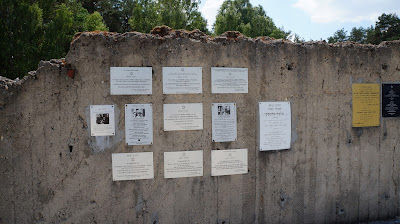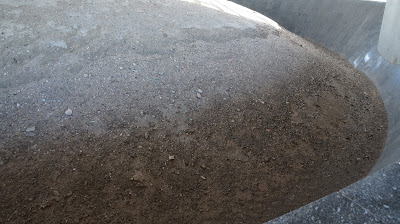I’ll apologize in advance for the length. I’ve seen a lot
and haven’t had the time or internet to post until now, so it is a longer post
than I’d normally publish.
It has been one long and empty Polish road after another as
I went from city to city, and off into the middle of nowhere to see additional
camps in Poland. There are six death camps in Poland and in order to see them
all I had to travel for hours by car, view the site, and then leave to make it
to the next site. I think I was able to plan it out enough in advance that for
the most part I haven’t been rushed at any of the sites. Fortunately, since I
knew where I was going I did a lot of research and reading about each of the
sites in advance so I would know what I was seeing, the history of the camp,
and how they all fit into the vast web of mass murder.
After leaving Oświęcim I headed to Krakow, which I had the
luck to have visited last time I was in Poland with Eastern Michigan
University. I had some lunch in the old city square, overlooking a festival and
horse drawn carriage rides. Following lunch, I did some shopping at the amazing
market in the center of the square. On my previous visit I didn’t have extra
money to buy much of anything, and this time I saved up for months so I could
buy a couple of special presents for a few family members. Krakow is known for
its amber jewelry, and it is indescribably beautiful.
Following lunch, it was back on the road so that I could
make the next stop. Lunch took 10x longer than I planned so I attempted to head
right to Belzec, but it became clear that I needed to just head to my hotel in
Lublin. The hotel was amazing! It sat right at the base of a castle and was
feet from the old town square. I had an amazing dinner looking over the
beautiful city all lit up as darkness fell. I can easily understand how it is
that this city is talked about as one of the most beautiful places to visit. It
is already on my list to come back and stay for a week, truly beautiful.
The next morning I was determined to get back on schedule,
which meant countless miles and a very long day. I got up early and headed out
on the road. The first stop was Majdanek, which is notorious because as the
first camp to be liberated, it was liberated so fast that the guards only had
time to flee and couldn’t hide what they had done. So the liberators found
bodies, crematoria, and more importantly, fully functional gas chambers. It is
here that you can step into a camp that could begin operations today. It is
beyond my ability to describe the feeling of standing in a gas chamber with
walls discolored by the use of Zyklon B. At Majdanek many different methods for
killing were used. The guards used firing squads, carbon monoxide, and Zyklon B
as the camp, and its killing capacity evolved over time.
Here are some pictures of the first part of the camp including
the gas chambers:
After going through the gas chambers and the first barracks you,
see an art installation that is meant to represent the unknown victims of the
camp, of which there are many. While I am generally skeptical of art that
attempts to capture the Holocaust, this was possibly one of the most moving
exhibits I’ve ever seen. You walk into a mostly dark barracks with just dim
lights and you can hear many people taking in different languages. Many lights
are suspended from the ceiling and are wrapped in barbed wire. To stand here,
feel, see, and smell all of the elements are an overwhelming experience. You
feel both anxious, and sad, and completely uneasy, I have only had this feeling
a few other times in my life and it is a unique piece of art that can evoke
these feelings so immediately.
Here are some pictures of the art installation:




Finally, there are the memorials. The first is located just
as you walk into the camp and is so incredibly massive that it defies logic.
Which, if you really think about it, is fitting. The events that took place
here often defy our logic of how the world works, what is logical, and the
basic principles of human decency for our fellow man. A straight line back to
the back of the camp is the second memorial. Located next to the crematoria
used to burn those that had been murdered and hide the evidence was a mammoth
domed monument. Once I made it to the far end of the camp I quickly realized
that under this dome was a truly massive mount of human ashes. It is jaw dropping.
Here are the cremated remains of countless innocent men, women, and children. Once
I was able to wrap my mind around the monument as a whole I began to notice
pieces that didn’t look like normal ash, this is when I noticed that there were
actual pieces of bone in with the cremains. Beyond my experience with the
display of bodies at sites of the Rwandan Genocide, this was one of the most
graphic and grotesque sites I’ve seen. But this is a completely unique
experience and memorial that I have to admit provides a completely different
dimension of understanding of the scale of the atrocities committed here. How
do you visualize thousands of people, much less hundreds of thousands or
millions of people? Making people understand the scale is one of the major
challenges and I think that this memorial effectively adds one more piece to
the puzzle of my understanding.
Here are pictures of the two memorials:
Following the visit to Majdanek it was back in the car for a
two hour drive to Bełżec. Once I got to the town I had to figure out exactly
where the monument was. There are few signs that direct you immediately to the
memorial. After a little trial and error, I pulled up to this massive memorial.
The first thing you see is the wall for the compound and the memorial rising up
behind it. As I walked up to the gate, I saw an inscription mounted to the
wall. The metal that made the inscription had began to rust and was bleeding
its color onto the wall, providing a possibly unintended, but completely bone
chilling visual as I entered the camp. Here is a picture of the inscription:

When I walked into the memorial, I was immediately struck by
the immense size of the memorial. It is unbelievably large and is unique to the
camp. It honors the countless killed, while telling the story of the horrors
that unfolded here. I will end the description here, because the pictures will
do a much better job showing you what the memorial is like. Here are a few
pictures:



Following Bełżec I had to jump back in the car for a 3 hour
(give or take a few stops + several dozen tractors slowing me down) to get to Sobibór.
I was so focused on what the GPS was telling me that I originally missed it and
ended up going down a two track lane into the middle of the forest… which is a
little unsettling in the middle of nowhere near the Ukrainian border! After a
backtrack I realized where the camp was, only to find out it was technically
closed. Luckily, the guard allowed me to go back when I explained I had come
from America and that I studied this and worked with Holocaust survivors. He
told me not to touch anything I shouldn’t and I could go back. After walking
down a long trail, I came to the area that excavation work is currently
underway. It is here that they have been excavating the site of the gas
chambers. Most of it was covered, but you could crouch down and see what was
under the propped up tarps. You could easily see the foundations of the gas
chambers. I felt privileged to see this fragment of the history as well as to
be allowed back where others were turned away. Walking around the roped off
area I made it to the official memorial. Here the monument mimics that of the
pile of ashes at Majdanek, though it was made of gravel instead. It was also
massive, which is fitting because of the events that transpired here. Walking
back a little ways towards the car I came across a path of remembrance that had
rocks with plaques commemorating some who died here, with individual names. At
the end of the trail was a small memorial. It was surreal to stand where
thousands lost their lives, alone, and hear nothing but the breeze through the
trees, and the subsequent creaking of the trees against the strain. I walked
back to the car and spotted in the tall overgrown bushes and weeds the infamous
metal train sign for Sobibor. After some perilous climbing around some tracks
and bushes, I made it to the sign where I was able to get a few pictures. Here
are pictures of Sobibór:







Following this visit, it was time to head about 3 hours to Warsaw
to check into the hotel. I went to bed and in the morning was back up to go
visit Treblinka, the 4th camp in 2 days. It’s only about 1.5 hours
from Warsaw and was a much easier drive than the previous monuments. I arrived
and made my way in the oppressive heat and in a swarm of the largest flies I’ve
ever seen in my life to the memorial for the death camp. Here the memorial is
again larger than you can imagine. As I started walking near the center
memorial, the largest object in the memorial I realized that the ground around
it was sand that apparently was home to thousands of yellow jackets. There was
a constant buzz of their wings and thousands patrolled the area. I carefully
navigated my way through the infested zone without being stung and continued to
view the memorial. Here are pictures of the memorial:























Following the memorial, I traveled farther down the road
where I saw the labor camp and then the execution sites/ graveyard farther
back. Pictures included above.
Following the rest of the memorials and visiting the
recently opened museum, it was back in the car to spend the afternoon in
Warsaw. Tomorrow I head to Chełmno extermination camp and then on to Berlin.






















































































